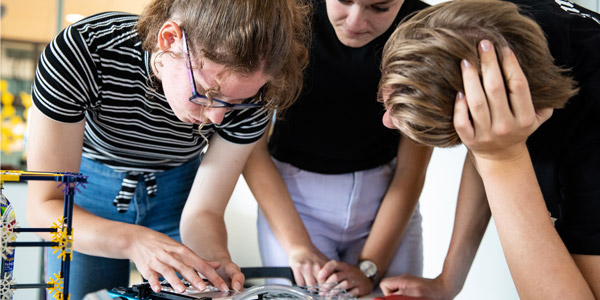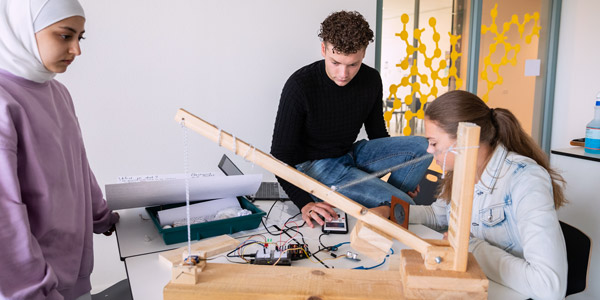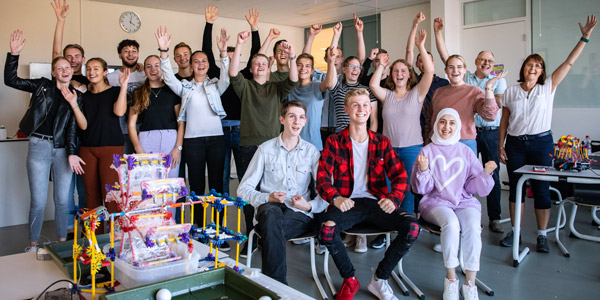Physics project: students sprint towards sustainable waste solutions
Posted 23/10/2020 by Sónia Reis
After lockdown, the new school year got off to a flying start for senior high school physics students at the Martinuscollege in the Dutch town of Grootebroek. As part of their school exams, they took part in a four-week project to develop sustainable solutions for waste processing. They used scrum methodology and sprints to come up with their own solutions using TI-Nspire™ CX technology and coding in Python. “We had to make them go home at the end of the school day, that’s how enthusiastic they were,” laughed senior school team leader Hanneke Doodeman.
.jpg)
Freedom to solve problems
Separating out metal, developing greener ways to collect waste, fishing plastic out of water, washing glass and compressing domestic rubbish — these are the sustainable waste solutions which the students worked on. Using scrum, they were able to work independently, and this gave them the freedom to solve problems. “It’s challenging for both teachers and students,” said physics teacher Cathy Baars, who devised the project, “because the resulting product is not fixed.”Student Lune and her group looked at separating metal from waste and admitted that this gave her some stress. “We had a lot of setbacks, and something broke down every lesson,” she said. “But now it works perfectly. We programmed the magnet to be active for eight seconds. It removes the metal from the waste, and a conveyer belt takes away what is left.”
Getting the wheels turning
Physics teacher Baars combined parts of the curriculum into the project, which accounts for 9% of students’ final exam scores. “Technical design, automation, physics, climate and even career orientation is part of this project,” she said. In terms of technology, the students used their own Texas Instruments graphing calculators, the TI-Innovator™ Hub and the Rover robot car, as well as servo motors, sensors, electromagnets and breadboards. “What helps is that students associate this equipment with play,” said Doodeman. “And that means they get involved. Physics becomes less abstract and is visualised. The students were coding fanatically and then testing to see if it works. They are busy physically, and at the same time, the wheels in their heads are turning.”
Encouraging girls to code
The students were quick to take to coding with Python. Marijke wrote code for the rubbish lorry project, which involved placing a waste disposal vehicle on the Rover robot car. The robot travelled up and down, while its arms picked up different sorts of waste. “Writing the code was easy,” said a smiling Marijke. “We’ve had more problems with the actual construction!”The students were introduced to Python during the lockdown when they had remote lessons. “Working from home actually went pretty smoothly,” said Baars. “If they got stuck, they could share the code via chat, and we could look at it together. Many of the girls enjoyed my assignment to make graphic art, and it helped motivate them to learn Python. And that is why during the sustainability project, it was often girls who did the programming.”

Solving environmental problems
The students enjoyed solving problems related to the climate. “I like these lessons because we are working on innovations, and we are actually making things,” said a student who was involved in the plastics solution.“Many of them think ‘other people’ are in charge of solving sustainability issues,” said Baars. “This project showed them that they too can work on finding useful solutions. For me, that is one of the successes of this project.”

Hoping for a snowball effect
Baars recommends organising STEM projects to other teachers. “Take a look at the curriculum,” she said. “There is always room for a project like this. And don’t worry if you don’t have all the skills. I have two left hands and am useless at building things, but the students often can. Just try it!”Her department head is very happy with the project. “The involvement of the teachers has been crucial for the success of the projects,” said Doodeman. “Our classrooms have large windows, and many teachers saw how enthusiastic everyone has been during physics classes. I’m hoping for a snowball effect.”
